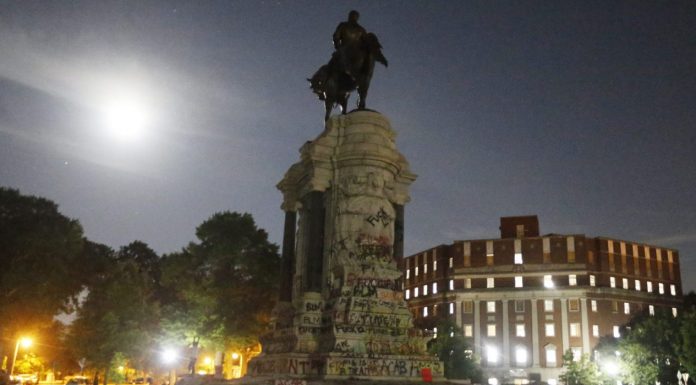(Headline USA) The last of the Confederate monuments prominently displayed along Richmond‘s eponymous Monument Avenue has been cleared for removal as radical leftists in Virginia who have long cringed at the historical relics conclude their decades-long cancel-culture crusade.
Ironically, it happened on the watch of a governor and attorney general who were, only two years earlier, enmeshed in separate blackface scandals that threatened to derail their political careers and restore GOP power to the once solid-red state that had been the seat of the Confederacy and a central theater of the Civil War.
?BREAKING? We have won the case to remove the Robert E. Lee statue from Monument Avenue. The Supreme Court of Virginia has dissolved all injunctions and the statue may now come down. A big win for a more inclusive Commonwealth! pic.twitter.com/Fdtl8wU0YB
— Mark Herring (@MarkHerringVA) September 2, 2021
The Supreme Court of Virginia ruled Thursday that the state can take down an enormous statue of Confederate Gen. Robert E. Lee that served as a landmark in the state’s capital for more than a century.
While Richmond officials had used emergency orders last summer to unceremoniously remove the statues of several other prominent generals, local residents fought the removal of Lee with court-ordered injunctions, citing the impact on property values due to its historical designation.
The high court’s ruling came in two lawsuits filed by Virginia residents who attempted to block removal of the 21-foot bronze equestrian sculpture, which shows Lee in military attire atop a 40-foot pedestal.
The court found that “restrictive covenants” in the 1887 and 1890 deeds that transferred the statue to the state no longer apply, essentially stating that the current elected officials had the authority to do whatever they wanted when it came to matters concerning government property.
“Those restrictive covenants are unenforceable as contrary to public policy and for being unreasonable because their effect is to compel government speech, by forcing the Commonwealth to express, in perpetuity, a message with which it now disagrees,” the justices wrote.
Disgraced Democrat Gov. Ralph Northam announced his decision to remove the statue in June 2020, 10 days after George Floyd’s death sparked riots across the country, including Richmond. The Lee statue was vandalized in the process, and its base is now covered with graffiti.
Separate lawsuits were filed by a group of residents who own property near the statue and a descendant of signatories to the 1890 deed that transferred the statue, pedestal and land they sit on to the state.
Descendant William Gregory argued that the state agreed to “faithfully guard” and “affectionately protect” the statue.
And five property owners argued that the governor is bound by a 1889 joint resolution of the Virginia General Assembly that accepted the statue and agreed to maintain it as a monument to Lee.
During a hearing before the Supreme Court on June 8, attorneys for the plaintiffs argued that the Virginia Constitution does not grant the governor the authority to remove the statue. But Attorney General Mark Herring’s office said a small group of private citizens cannot force the state to maintain a monument that no longer reflects its values.
“Today is an historic day in Virginia. Today, we turn the page to a new chapter in our Commonwealth’s history—one of growth, openness, healing, and hope,” Herring said in a statement Thursday.
Patrick McSweeney and Joseph Blackburn Jr., attorneys for the plaintiffs, could not immediately be reached for comment on whether they plan to appeal the ruling to the U.S. Supreme Court.
A spokeswoman for Northam said his office would have comment soon.
It wasn’t immediately clear how soon work could proceed on the removal, a job that will require special heavy equipment. The state has been working on detailed plans that include the extrication of a time capsule thought to be tucked inside the base.
Earlier this summer, Northam’s office said it intended to leave in place the statue’s enormous pedestal, as efforts are underway to rethink the design of Monument Avenue. Some left-wing activists see the defaced eyesore as a symbol of the protest movement that erupted after Floyd’s killing and don’t want it moved.
The Lee statue was the first of five Confederate monuments to be erected on Richmond’s Monument Avenue, at a time when the Civil War and Reconstruction were long over, as the two sides in the deadly conflict undertook a sort of reconciliation process and the Daughters of the Confederacy began to memorialize war veterans in ways that sometimes overly sentimentalized the antebellum South.
Like many Southern, aristocratic landowners, Lee was a slaveholder prior to the war. He ultimately made the decision to surrender the war and was subsequently repatriated, serving in his later years as president of what would become Washington and Lee University until his 1870 death.
When the statue arrived in 1890 from France, where it was created, thousands of Virginians used wagons to help pull it in pieces for more than a mile to the place where it now stands.
The city of Richmond, which was the capital of the Confederacy for most of the Civil War, has removed more than a dozen other pieces of Confederate statuary on city land since last year’s riots.
Adapted from reporting by the Associated Press

